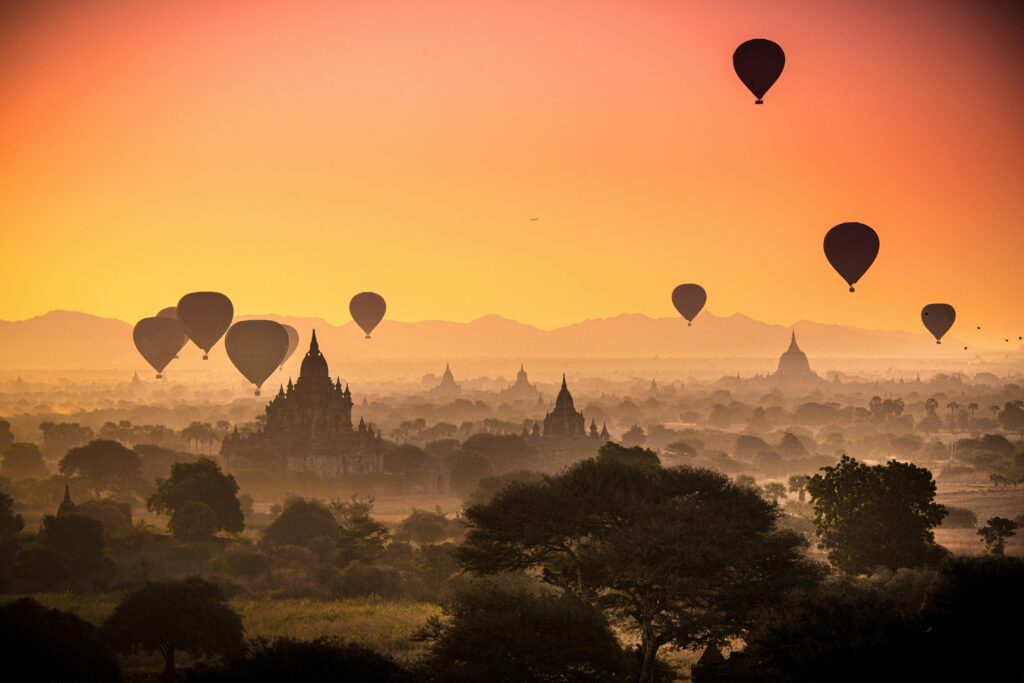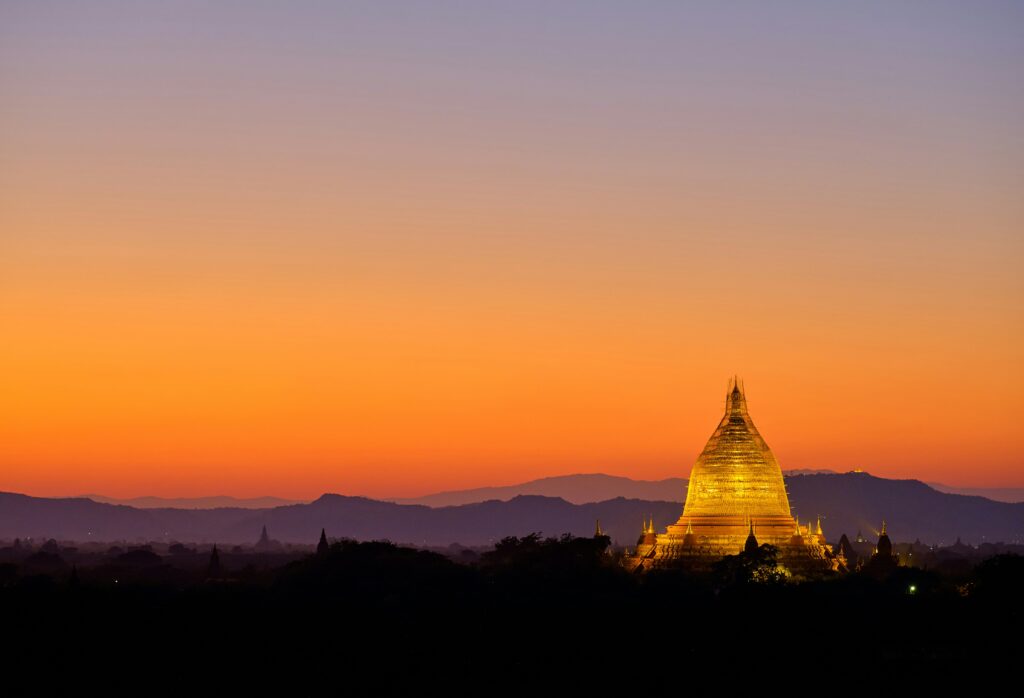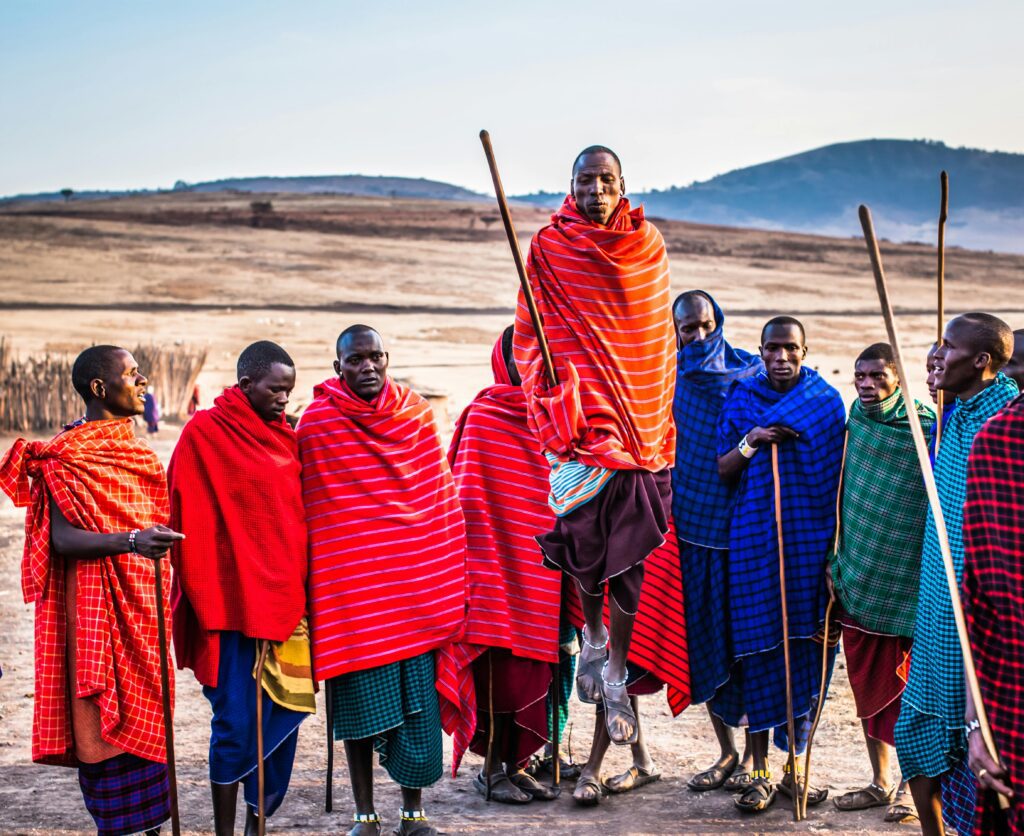Introduction to Bagan (Myanmar)
Bagan (Myanmar), an ancient city in Myanmar’s Mandalay Region, is one of Southeast Asia’s most breathtaking archaeological wonders. With over 2,000 temples and pagodas scattered across a vast plain, this UNESCO-listed site rivals Cambodia’s Angkor Wat in grandeur. Whether you’re a history buff, photographer, or backpacker, Bagan (Myanmar) offers an unforgettable journey into Myanmar’s spiritual and cultural heart.
Why Visit Bagan (Myanmar)?

- UNESCO World Heritage Site (since 2019)
- Sunrise & sunset views from temple rooftops
- Hot air balloon rides (seasonal) over the temple plains
- Rich Buddhist heritage with intricate murals and stupas
Pro Tip: Visit before peak tourism resumes—Bagan (Myanmar) remains blissfully uncrowded compared to other global heritage sites.
Map of Myanmar
Planning Your Trip to Bagan (Myanmar)
Best Time to Visit Bagan (Myanmar)
The ideal time is November to February (cool, dry season). Avoid March–May (scorching heat) and June–October (monsoon rains).
| Season | Weather | Crowds | Balloon Availability |
|---|---|---|---|
| Nov–Feb | Mild (20–30°C) | Moderate | Yes |
| Mar–May | Hot (up to 40°C) | Fewer tourists | No (too windy) |
| Jun–Oct | Rainy, humid | Minimal | No |
Essential Items to Pack
- Lightweight, modest clothing (shoulders/knees covered for temples)
- Sturdy sandals (for climbing temples)
- Sunscreen & wide-brimmed hat
- Reusable water bottle (tap water is unsafe)
- Power bank (electricity outages occur)
Personal Anecdote: I forgot my hat and ended up buying a traditional gaung baung (Burmese turban) from a local vendor—best $3 spent! The vibrant green fabric not only shielded me from the sun but also earned me smiles from locals who appreciated the cultural nod.
Visa & Entry Requirements
- eVisa required for most nationalities (~$50, valid 28 days)
- Passport must have 6+ months validity
- COVID-19 restrictions (check updates here)
Pro Tip: Apply for your eVisa at least two weeks in advance to avoid delays. Upon arrival, keep a printed copy of your visa approval and hotel reservation handy for immigration.
Getting Around Bagan (Myanmar)
Local Transportation Options
| Option | Cost (USD) | Pros | Cons |
|---|---|---|---|
| E-bike | $5–8/day | Flexible, fun | Limited range |
| Bicycle | $2–3/day | Cheap, eco-friendly | Exhausting in heat |
| Private car | $40–60/day | AC comfort | Expensive |
| Horse cart | $15–20/day | Traditional experience | Slow |
Pro Tip: Rent an e-bike early—shops run out by 9 AM! For a more immersive experience, hire a horse cart driver for a half-day tour. Mine, named Ko Tin, shared fascinating stories about his family’s generations-long connection to the temples.
Detailed Transportation Guide
- E-bikes: Most rentals include a map and helmet. Charge overnight (most guesthouses offer charging stations).
- Taxis: Negotiate fares upfront. A trip from Nyaung U to Old Bagan costs ~$10.
- Buses: Local buses between towns are cheap ($1) but crowded and infrequent.
Where to Stay in Bagan (Myanmar)
Budget Accommodations
- Ostello Bello Bagan ($10–15/night) – Social hostel with free breakfast and temple-view rooftop.
- Shwe Na Di Guesthouse ($20/night) – Cozy rooms with AC, run by a friendly Burmese family.
Mid-Range Options

- Bagan Thande Hotel ($50–70/night) – Riverside location with lush gardens and sunset views.
- Kumudara Hotel ($60/night) – Traditional teak bungalows near Ananda Temple.
Luxury Stays
- Aureum Palace Hotel ($150+/night) – Private villas with pool access and hot air balloon views.
- Bagan Lodge ($120/night) – Modern resort with spa and guided temple tours.
Personal Recommendation: Waking up at Bagan Thande to the sound of monks chanting and the Irrawaddy River gently flowing was pure magic. Their mango pancakes at breakfast are a must-try!
3-Day Bagan (Myanmar) Itinerary
Day 1: Temple Hopping & Sunset Magic
Morning:
– 5:00 AM: Sunrise at Shwesandaw Pagoda (arrive by 4:30 AM to secure a spot). The climb is steep, but the 360-degree view of mist-covered temples is worth it.
– 8:00 AM: Explore Ananda Temple, Bagan’s crown jewel. Admire the four standing Buddhas and intricate jatakas (moral tales) carved into the walls.
Afternoon:
– 12:30 PM: Lunch at Weather Spoon’s Bagan. Must-try: Tea-leaf salad (fermented tea leaves with crunchy beans) and Shan-style noodles.
– 2:30 PM: Visit Dhammayangyi Temple, the largest and most mysterious. Local legend says its builder, King Narathu, murdered his father and brother to ascend the throne—and the temple’s uneven brickwork is said to reflect his cruelty.
Evening:
– 5:00 PM: Sunset at Buledi, a quieter alternative to Shwesandaw. Bring a flashlight for the descent!
– 7:00 PM: Night market in Nyaung U. Try mont lin ma yar (fried rice cakes) and bargain for lacquerware.
Day 2: Balloons, Lacquerware & Local Life
Morning:
– 5:30 AM: Hot air balloon ride with Oriental Ballooning ($350). Floating above the temples at sunrise, with only the sound of the burner interrupting the silence, is surreal.
– 9:00 AM: Visit Myinkaba Village for lacquerware workshops. Watch artisans layer bamboo with resin and paint intricate designs—a 6-month process!
Afternoon:
– 12:00 PM: Lunch at Starbeam Bistro (their coconut curry is heavenly).
– 2:00 PM: Manuha Temple, home to a cramped reclining Buddha—symbolizing the captive Mon king’s suffering.
– 3:30 PM: Nan Paya Temple, famed for its sandstone carvings of Brahma holding lotus flowers.
Evening:
– 6:00 PM: River cruise on the Irrawaddy with BBQ dinner ($15). Spot dolphins if you’re lucky!
Day 3: Off-the-Beaten-Path Adventures
Morning:
– 5:30 AM: Sunrise at Lawkananda Pagoda, where locals offer flowers to the riverside Buddha.
– 8:00 AM: Mount Popa day trip (2-hour drive). Climb the 777 steps (beware of cheeky monkeys!) to the golden stupa.
Afternoon:
– 1:00 PM: Local cooking class at Flavor of Bagan. Learn to make mohinga (fish noodle soup) with lemongrass and banana stem.
Evening:
– 7:00 PM: Stargazing at a secluded temple. The lack of light pollution makes for incredible Milky Way views.
Budget Considerations
Daily Costs (Per Person)

| Category | Budget ($) | Mid-Range ($) | Luxury ($) |
|---|---|---|---|
| Accommodation | 10–15 (hostel) | 30–60 (guesthouse) | 100+ (resort) |
| Food | 5–10 | 15–25 | 30+ |
| Transport | 5 (e-bike) | 20 (taxi) | 50 (private car) |
| Activities | 0 (temples) | 30 (balloon viewing) | 400 (balloon ride) |
Money-Saving Tip: Temples are free, but the Bagan Archaeological Zone Fee ($15) is required at entry. Skip the balloon ride and enjoy sunset from a temple instead.
Cultural Etiquette & Safety Tips
Do’s and Don’ts
✔ Do:
– Remove shoes and socks before entering temples (floors get scorching hot—time your visits for early morning or late afternoon!).
– Donate a small amount if a local guide shows you hidden murals.
– Learn basic Burmese phrases like mingalaba (hello) and chezu tin ba deh (thank you).
✖ Don’t:
– Point feet at Buddha statues (considered deeply offensive).
– Wear red or black clothing to temples (associated with negativity).
Safety Note: Avoid climbing unstable temples. In 2016, a tourist died after a collapse at Dhammayangyi.
Frequently Asked Questions (FAQs)
1. Is Bagan (Myanmar) safe for solo travelers?
Yes! Violent crime is rare, but women should avoid isolated temples at night. Stick to well-lit areas like Nyaung U Market after dark.
2. Can I use credit cards in Bagan (Myanmar)?
Most places are cash-only (USD/Kyat). ATMs dispense Kyat but charge high fees—bring crisp $50/$100 USD bills for the best exchange rates.
3. How many days do I need?
3 days is ideal for temples, balloons, and Mount Popa. Add an extra day if you want to cycle to remote temples like Tuyin Taung.
4. Are hot air balloons worth it?
If your budget allows—yes! The sunrise views are unparalleled. Book early; only 3 companies operate (Balloons Over Bagan, Oriental, Golden Eagles).
5. What’s the best way to avoid crowds?
Visit sunrise spots like Buledi instead of Shwesandaw. For solitude, head to Sulamani Temple at midday when tour groups leave for lunch.
6. Is bargaining acceptable?
Yes, in markets (aim for 30% off initial prices). Never haggle over temple donations.
7. Can I fly a drone in Bagan?
No. Drones are banned to protect the temples’ integrity.
My Personal Experience in Bagan (Myanmar)
I’ll never forget sipping sugarcane juice at a roadside stall while watching monks collect alms at dawn. The scent of jasmine offerings and the distant hum of chanting created a surreal moment of peace.
Another highlight? Befriending a local artist who showed me how gold leaf is applied to Buddha statues—a sacred tradition passed down for generations. He explained that women aren’t allowed to touch the statues, as their “impure energy” might disrupt the spiritual balance.
One evening, I got lost cycling back to my guesthouse and stumbled upon a family cooking htamin jin (fermented rice salad) over a fire. They invited me to join, and we shared stories despite the language barrier. It reminded me that Bagan’s true magic lies in its people.
Recommended Tours & Activities
- Balloons Over Bagan (Oct–Apr) – The original and most reputable operator.
- Sunset e-bike tour with Bagan Bike (includes hidden temples like Payathonzu).
- Irrawaddy River cruise with Aye Yar River View Restaurant (book the upper deck for sunset).
CTA: [Removed promotional link]
Conclusion: Start Your Bagan (Myanmar) Adventure!
From golden sunrises to ancient wonders, Bagan (Myanmar) is a destination like no other. Use this guide to plan your trip, respect local customs, and immerse yourself in Myanmar’s magic.
Ready to explore? Book your flights and prepare for the journey of a lifetime!
Keywords: Best Bagan (Myanmar) travel guide, 3-day Bagan (Myanmar) itinerary, Bagan (Myanmar) backpacking tips, Bagan (Myanmar) temples, Bagan (Myanmar) tourism, Shwesandaw Pagoda, Ananda Temple, hot air balloon Bagan (Myanmar).



